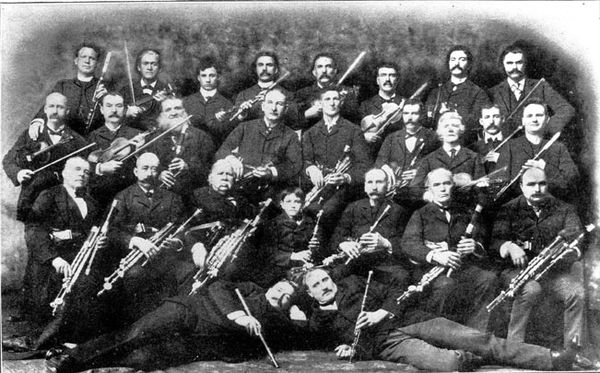Annotation:Yellow Wattle (2): Difference between revisions
No edit summary |
No edit summary |
||
| (3 intermediate revisions by 2 users not shown) | |||
| Line 1: | Line 1: | ||
---------- | |||
---- | {{TuneAnnotation | ||
|f_tune_annotation_title= https://tunearch.org/wiki/Annotation:Yellow_Wattle_(2) > | |||
'''YELLOW WATTLE [2]''' (An Bata Buide). Irish, Double Jig. D Major. Standard tuning (fiddle). AABB (Sullivan): AABBCCDD (O’Neill). Distantly related to "[[Yellow Wattle (1)]]". The 2nd, 3rd and 4th strains correspond to mid-19th century uilleann piper and collector James Goodman's "[[Yellow Wattle (5)]]." Abeyta et al <ref>Abeyta et al, '''Drawing from the Well''', 2010, p. 17.</ref> note that the first strain, not replicated in any other versions, is reminiscent of the first strain of O'Neill's "[[Church Hill]]." The authors speculate that source Timothy Dillon may have adapted that part and prefixed it to a three-part setting of "Yellow Wattle." | |f_annotation=[[File:irishmusicclub.jpg|600px|thumb|left|Chicago Irish Music Club, c. 1903. Timothy Dillon is standing in the back row, 5th from left (next to Chief O'Neill)]]'''YELLOW WATTLE [2]''' (An Bata Buide). Irish, Double Jig (6/8 time). D Major. Standard tuning (fiddle). AABB (Sullivan): AABBCCDD (O’Neill). Distantly related to "[[Yellow Wattle (1)]]". The 2nd, 3rd and 4th strains correspond to mid-19th century uilleann piper and collector James Goodman's "[[Yellow Wattle (5)]]." Abeyta et al <ref>Abeyta et al, '''Drawing from the Well''', 2010, p. 17.</ref> note that the first strain, not replicated in any other versions, is reminiscent of the first strain of O'Neill's "[[Church Hill]]." The authors speculate that source Timothy Dillon may have adapted that part and prefixed it to a three-part setting of "Yellow Wattle." | ||
<br> | <br> | ||
<br> | <br> | ||
"Yellow Wattle" has also been called "[[Jackson's Yellow Twigg]]," invoking the name of Walker "Piper" Jackson, of Lisduan, Balligarry, County Limerick, who died in 1798. More tunes have been attributed to him than he could possibly have written, so the thinking goes, and this tune would seem to predate him. "Jackson's Yellow Twigg" was mentioned in a list of tunes played by [[biography:Isaac Isaacs]], a German-born Jewish hammered dulcimer player of some renown in Dublin in the late 18th century<ref>Further information can be found in Seán Donnelly, "A German Dulcimer Player in Eighteenth-Century Dublin", '''Dublin Historical Record''', Vol. 53, No. 1 (Spring, 2000), pp. 77-86</ref> | |||
|f_source_for_notated_version=Francis O'Neill had the tune from fiddler and patrolman Timothy Dillon, originally from County Kerry. He received a sketch in '''Irish Minstrels and Musicians''' (1913, p. 395): | |||
[[ | |||
'' | |||
<blockquote> | <blockquote> | ||
''When it comes to traditional fiddle-playing in its most cultured sense, no one displays such marked individuality'' | ''When it comes to traditional fiddle-playing in its most cultured sense, no one displays such marked individuality'' | ||
| Line 30: | Line 28: | ||
''at peace with the world; able and willing to entertain all comers with music and true Irish hospitality.''<br> | ''at peace with the world; able and willing to entertain all comers with music and true Irish hospitality.''<br> | ||
</blockquote> | </blockquote> | ||
|f_printed_sources=O'Neill ('''Dance Music of Ireland: 1001 Gems'''), 1907; No. 353, p. 73. Sullivan ('''Session Tunes vol. 3'''); No. 6, p. 3. | |||
|f_recorded_sources= | |||
|f_see_also_listing=Alan Ng's Irishtune.info [https://www.irishtune.info/tune/2089/]<br> | |||
Alan Ng's Irishtune.info [https://www.irishtune.info/tune/2089/]<br> | |||
Jane Keefer's Folk Music Index: An Index to Recorded Sources [http://www.ibiblio.org/keefer/y01.htm#Yelwa]<br> | Jane Keefer's Folk Music Index: An Index to Recorded Sources [http://www.ibiblio.org/keefer/y01.htm#Yelwa]<br> | ||
Hear versions of the jig on youtube.com [https://www.youtube.com/watch?v=wpAkgNhImjU] [https://www.youtube.com/watch?v=i_Qsb3oPoIk]<br> | Hear versions of the jig on youtube.com [https://www.youtube.com/watch?v=wpAkgNhImjU] [https://www.youtube.com/watch?v=i_Qsb3oPoIk]<br> | ||
}} | |||
------------- | |||
---- | |||
Latest revision as of 04:39, 26 September 2021
X:1 T:Yellow Wattle [2], The L:1/8 M:6/8 S:O’Neill – Dance Music of Ireland: 1001 Gems (1907), No. 353 Z:AK/Fiddler’s Companion K:D dcA AGE|ABA AGE|dcA AGE|GAG GED| dcA AGE|ABA AGE|dcA ABc|dcA GED:| |:G2G AEE|AGG AEE|G2G AEE|AGG GEA| G2G AEE|AGG AEE|G2G ABc|dcA GED:| |:DFA DEE|DFA GED|DFA DEE|DEF GED| DFA DEE|DFA GED|DFA ABc|dcA GED:| |:E/F/GE FED|AFD FED|E/F/GE FED|GEA GED| E/F/GE FED|AFD FED|DFA ABc|dcA GED:|

"Yellow Wattle" has also been called "Jackson's Yellow Twigg," invoking the name of Walker "Piper" Jackson, of Lisduan, Balligarry, County Limerick, who died in 1798. More tunes have been attributed to him than he could possibly have written, so the thinking goes, and this tune would seem to predate him. "Jackson's Yellow Twigg" was mentioned in a list of tunes played by biography:Isaac Isaacs, a German-born Jewish hammered dulcimer player of some renown in Dublin in the late 18th century[2]

